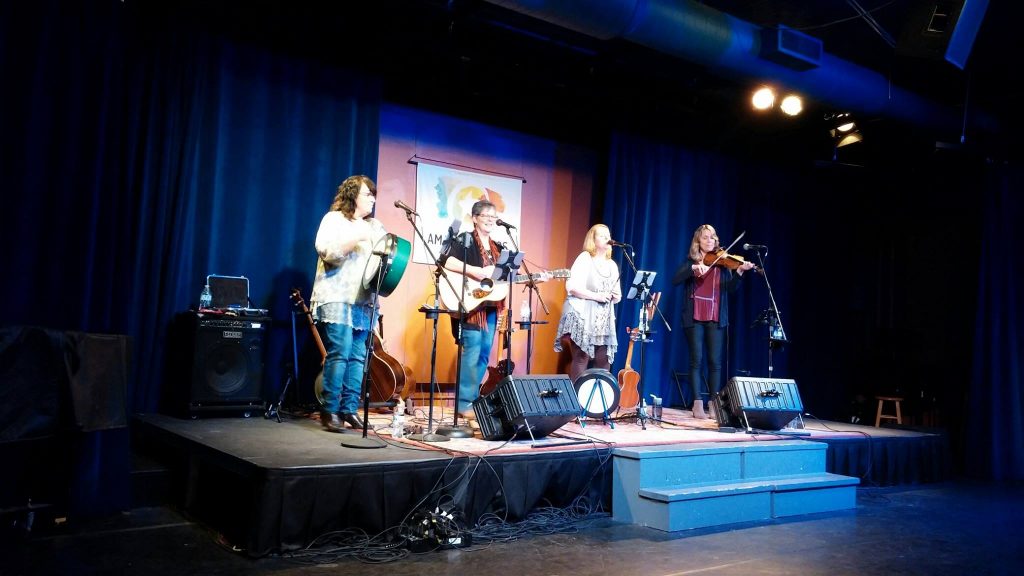Posted on January 15, 2018by The BCMFest Blog
Another in a series of features about BCMFest 2018 that will be appearing in this blog right up until the festival (January 18-21), so as to better acquaint you with the events, activities and personalities that make up BCMFest, which is marking its 15th anniversary.
It’s all well and good to sit and listen to music, and you’ll get plenty of chances to do that at BCMFest. But Celtic music was made for sing-alongs, and you’ll have two special opportunities to raise your voice during Saturday Dayfest (January 20): First, with the Boston Harbor Bhoys at noon; and then at 4:45 p.m. with The Kelly Girls.

We asked Eddie Biggins of the Boston Harbor Bhoys and Kelly Girl Aisling Keating to talk about the art — and science — of getting audiences to sing along.
Q: Based on your long experience, do you think most people actually do like to sing — even if they say they can’t?
EDDIE: Yes! When we can get an audience singing, it really doesn’t matter how good you sound. It’s about the community of it, the participation. We think that on some level, most people like to sing.
AISLING: We absolutely believe that people want to sing along! Sometimes audiences tend be a bit shy, so we always find it most successful when we invite and entice them to join in. We like to teach the audience a chorus on an original tune that they might not be so familiar with, or just let them chime in on a song that is more familiar. Sharing music is a beautiful experience that creates an amazing connection between audience and performers and there is nothing more wonderful than when everyone lifts their voices to the rafters.
Q: If you have an audience that seems reluctant to join in, do you have any special techniques or shticks to get them singing?
AISLING: The best technique is simply to invite and encourage folks to join in! We love to have fun and connect with our audience. Us having fun, puts our audience at ease.
EDDIE: Sometimes shaming them into it works! Some people may be reluctant because they don’t know the words, so we encourage them to sing “la la la” if they don’t know it. And if an audience truly does not want to participate, well…you have to know when to give up, too. Sometimes they just prefer to listen.
Or, we can always launch into “Piano Man.” You can’t not sing along to that one!
Q: Obviously, with sing-alongs one tends to rely on songs that are likely to be familiar to most, but do you enjoy teaching songs that are maybe a little off the beaten track, too? What ones fall into that category?
EDDIE: It can be fun to teach something that the crowd might be less familiar with. We like to have the audience sing the “Day-I-Ay-I-Ay” parts of “The Galway Girl,” which is something they may not be used to. We seem to teach more hand clapping parts than singing parts (“Whiskey in the Jar,” “Wild Rover,” “Finnegan’s Wake”).
AISLING: We love to teach an audience a new song, particularly a band original.
Q: Off the top of your head, what are three songs you do that pretty much everybody will sing along to?
AISLING: We have songs old and new, original and traditional, that strike a balance with our audience feeling one minute they want to be quiet to listen to the story, the lyrics and harmonies, and then the next minute they want to sing and clap and join in! We perform original songs that have a hooky chorus like “Molly Kool” and audiences jump right in. And we sing some classic songs like ” Wild Mountain Thyme” or “Old Maid in the Garret” which always prompt a sing-along.
EDDIE: It depends on the audience. “The Wild Rover” is one that even non-Irish music crowds will seem to know. “Black Velvet Band” is another. When performing for seniors, we generally do a medley of old-time Irish-American songs specifically designed for singing along, including songs like “When Irish Eyes are Smiling” and “Too-Ra-Loo-Ra-Loo-Ral.” That gets everyone going.
And of course, there’s always “Piano Man,” but only if we have no other choice.
Schedules, ticket information and other details about BCMFest are available here.




